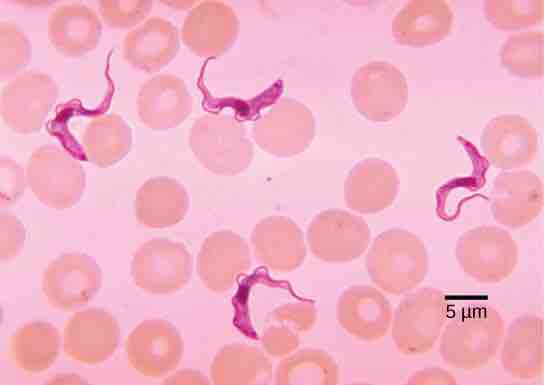Human Pathogens
A pathogen is anything that causes disease. Parasites live in or on an organism and harm that organism. A significant number of protists are pathogenic parasites that must infect other organisms to survive and propagate. Protist parasites include the causative agents of malaria, African sleeping sickness, and waterborne gastroenteritis in humans.
Plasmodium Species
Members of the genus Plasmodium must colonize both a mosquito and a vertebrate to complete their life cycle. In vertebrates, the parasite develops in liver cells and goes on to infect red blood cells, bursting from and destroying the blood cells with each asexual replication cycle . Of the four Plasmodium species known to infect humans, P. falciparum accounts for 50 percent of all malaria cases and is the primary cause of disease-related fatalities in tropical regions of the world. In 2010, it was estimated that malaria caused between one and one-half million deaths, mostly in African children. During the course of malaria, P. falciparum can infect and destroy more than one-half of a human's circulating blood cells, leading to severe anemia. In response to waste products released as the parasites burst from infected blood cells, the host immune system mounts a massive inflammatory response with episodes of delirium-inducing fever as parasites lyse red blood cells, spilling parasitic waste into the bloodstream. P. falciparum is transmitted to humans by the African malaria mosquito, Anopheles gambiae. Techniques to kill, sterilize, or avoid exposure to this highly-aggressive mosquito species are crucial to malaria control.

Plasmodium
Red blood cells are shown to be infected with P. falciparum, the causative agent of malaria. In this light microscopic image taken using a 100× oil immersion lens, the ring-shaped P. falciparum stains purple.
Trypanosomes
Trypanosoma brucei, the parasite that is responsible for African sleeping sickness, confounds the human immune system by changing its thick layer of surface glycoproteins with each infectious cycle . The glycoproteins are identified by the immune system as foreign antigens and a specific antibody defense is mounted against the parasite. However, T. brucei has thousands of possible antigens; with each subsequent generation, the protist switches to a glycoprotein coating of a different molecular structure. In this way, T. brucei is capable of replicating continuously without the immune system ever succeeding in clearing the parasite. Without treatment, T. brucei attacks red blood cells, causing the patient to lapse into a coma and eventually die. During epidemic periods, mortality from the disease can be high. Greater surveillance and control measures lead to a reduction in reported cases; some of the lowest numbers reported in 50 years (fewer than 10,000 cases in all of sub-Saharan Africa) have happened since 2009.

Trypanosomes
Trypanosomes are shown among red blood cells.
In Latin America, another species, T. cruzi, is responsible for Chagas disease. T. cruzi infections are mainly caused by a blood-sucking bug. The parasite inhabits heart and digestive system tissues in the chronic phase of infection, leading to malnutrition and heart failure due to abnormal heart rhythms. An estimated 10 million people are infected with Chagas disease; it caused 10,000 deaths in 2008.